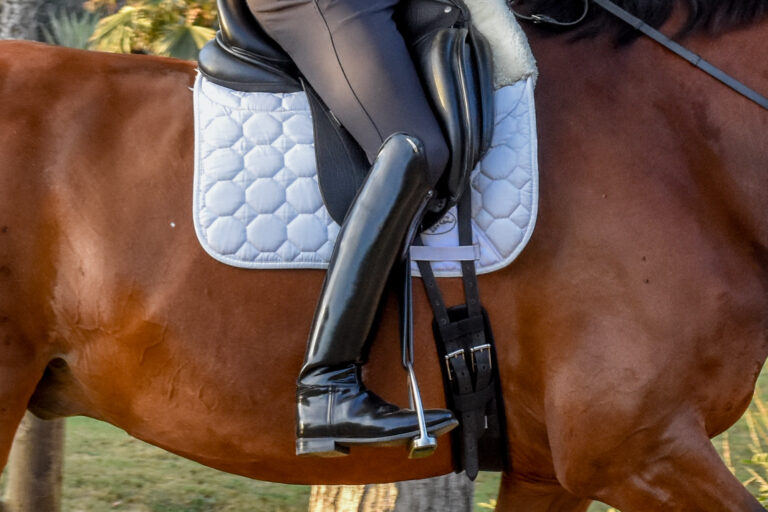There are three ways in which the horse’s hind legs work: thrusting power, reach and carrying power (engagement). A good dressage horse must be well developed in his ability and strength to utilize all three. Well-developed hind legs also require a strong, supple back to create the suspension bridge that connects the horse from back to front. The three ways in which the hind legs work are interrelated because each continuously builds on the other. The educated rider understands which of the three he is asking the horse to do and how to ask for it.
Thrust (Pushing Power)
Thrust refers to the horse’s ability to push himself forward off the ground. The hind leg that thrusts does so from a position of engagement in which it is solidly on the ground with the three joints of the leg bent equally carrying the weight. The horse then pushes against or off the ground with a powerful thrust that either propels him forward (in extended trot, for example) or up (as in passage) or to an extreme leap into the air (such as to a capriole).
To influence thrusting power, we ask the horse to go forward or we drive him when the desired hind leg is on the ground. In practical terms, this means that we would ask for a canter depart, for example, when the horse’s outside hind is on the ground at the first step of a canter stride, or we might ask for an extended trot when the inside hind is on the ground so that the horse can propel himself forward by pushing against the ground.
Reach
When the horse’s weight is on the outside hind, the rider can influence the inside hind to create greater closing–or articulation–of the joints and greater reach. When asking for greater reach, we influence the flight pattern of a hind leg when it is at its highest point and is articulated the most. At this moment, the opposite hind leg is on the ground and engaged, preparing for the moment of thrust. Movement within the horse’s stride happens rather quickly but as the rider is finding the rhythm of his horse, we want him to find the definite moment in time at which the leg is at its highest point–when it’s easiest to influence the flight pattern. In leg yielding, for example, we ask the horse to enlarge the circle at this moment so he can move his inside hind leg farther under his body toward the outside of the circle–either directing his inside hind foot into the hoof print of his outside front or toward a point under the outside stirrup of the rider.
Carrying Power (Engagement)
In the half halt that creates carrying power, we are asking the horse to slow down and carry more weight when the hind leg joints are closed and the hind foot is on the ground. The levade, in which the horse sits on his hindquarters, is the ultimate example of this kind of closing of the joints while carrying the weight. The timing of the half halt to the outside hind is the same as that used for the half halt to ask for reach from the inside hind since the outside hind leg is on the ground when the inside is in the air. The meaning of the term “engagement” has evolved over the years. Whereas the term used to imply “reach,” the current FEI working definition is: “Increased flexion of the joints of the hind leg during its weight-bearing phase. This causes a relative lowering of the hindquarters/raising of the forehand, thus shifting more of the task of load-bearing to the hindquarters. A prerequisite for upward/thrust impulsion.”
As the horse’s hind legs are strengthened in all three ways, he will reach a point at which collected gaits are possible. A certain degree of collection is necessary for voltes and lateral work, but collection really starts in the transitions–or in those few strides of preparation for a trot-to-halt transition, walk-to-canter transition or canter-to-walk transition. Collection is the culmination of carrying power, thrusting power and reach being developed equally. The quality of collection evolves, so the collected trot of a Grand Prix horse will be more lofty and powerful than that of a Second Level horse.
This article first appeared in the May 2004 issue of Dressage Today magazine.
George Williams is a U.S. Dressage Federation (USDF) gold medalist, successful international competitor and sought-after clinician. He began studying dressage in 1973 and earned his German bronze rider medal at the Reitinstitute von Neindorff. He was resident trainer for the Tempel Lipizzans in Illinois for 20 years and has trained with former U.S. dressage team coach Klaus Balkenhol. He is currently the vice president of the USDF, chair of the U.S. Equestrian Federation (USEF) High Performance Dressage Committee and a member of the USEF Dressage Committee, USEF High Performance Eligible Athlete Committee and USEF Board of Directors.











